- Home |
- Why With Us |
- About Us |
- Booking |
- Contact Us |
- Site Map


Everest High Passes with Ama Dablam Base Camp
25 days (ktm-ktm) Days from
This is one of the best of the Everest region trek which takes us through some of the most spectacular landscapes in the Nepal Himalaya along with the opportunity for visits to traditional Sherpa villages and gompas (monasteries), Buddhist culture, sacred peaks, lakes and valleys. As well as the majestic peaks, the Everest region is also an incredibly spiritual place where, during the course of this trip, we will have the opportunity to visit its many colorful gompas, have friendly conservation with the monks and a firsthand experience of the lifestyle of the Sherpa people residing in the region.
| Max. Elevation : 5545m | Grade : Strenuous |
| Best season : Oct-Dec&Feb-May | Type of trek : Tea houses/Lodges |
| Duration : 25 Days | Starting point : Lukla |
| Ending point : Kathmandu | Highlights : Nature |
This is one of the best of the Everest region trek which takes us through some of the most spectacular landscapes in the Nepal Himalaya along with the opportunity for visits to traditional Sherpa villages and gompas (monasteries), Buddhist culture, sacred peaks, lakes and valleys. As well as the majestic peaks, the Everest region is also an incredibly spiritual place where, during the course of this trip, we will have the opportunity to visit its many colorful gompas, have friendly conservation with the monks and a firsthand experience of the lifestyle of the Sherpa people residing in the region.
Some of the highlights of this treks are the visit to Chukung valley and climbing Chukung Ri, plus visits to Ama Dablam Base Camp, trek to Everest Base Camp and climbing Kala Patthar for a 360 degree panorama of Mt. Everest as well as all the surrounding peaks. Additionally other highlights include the visit to Gokyo lakes, climb to Gokyo Ri and crossing of the Renjo La to emerge in the pristine Thame valley. Throughout this epic journey, we are surrounded by spectacular 8000 meter peak panoramas, the serene landscapes and often unbelievably loaded Sherpa porters carrying the mountain of luggage as well as the herding Yaks forcing you to stop by to take in the scenery if case you were rushing too fast.
Early Spring & November are the perfect times for this trek with the peaks accentuated by clear, blue skies and without the hoards of trekkers who come during the peak months. Wildlife such as the Himalayan thar, musk deer, danphe (Himalayan pheasant, Nepal's national bird), blood pheasant, Himalayan snow-cock and snow-pigeon and chukkar roam the mountain-sides, and if you come in the Spring, it's rhododendron season, so the valleys are filled with reds, pinks and whites...!
Many would dream but you can make it a reality simply by joining us for this life changing experience - challenging yet rewarding beyond one’s imagination, this adventure is sure to exceed all expectations !
Highlights
- Renjo La, Cho La & Kongma La (passes)
- Everest Base Camp & the Khumbu Icefall
- Kala Pattar, Gokyo Ri & Chukhung Ri (peaks)
- The sublime Gokyo lakes & valley
- Remote Chukhung & Thame valleys
- Ama Dablam Base Camp
- Saturday Market at Namche Bazaar
- Lawudo, Pangboche, Namche, Thame & Khumjung Gompas (monasteries)
- Fascinating Sherpa Culture
- Colorful rhododendron forest, if trekking in the Spring
A challenging yet best of the Everest region trek through some of the most spectacular landscape in the Himalayas. Visit includes - Everest Base Camp - Kala Pattar (Peak) - Gokyo lakes, Ri (Peak), Amadablam Base Camp - Chhukung Ri (Peak) - Cho La, Renjo La & Kongma La (Passes)
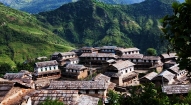
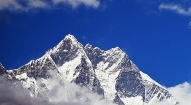
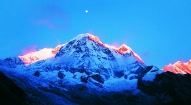
Brief Itinerary
Day 01: Kathmandu arrival (1340m)
Day 02: Kathmandu
Day 03: Fly to Lukla (2850m) - trek to Monjo (2835m)
Day 04: Trek to Namche Bazaar (3450m)
Day 05: Namche
Day 06: Trek to Phortse (3900m)
Day 07: Trek to Pangboche (3090m)
Day 08: Pangboche (option Amadablam BC -4450m)
Day 09: Trek to Dingboche (4300m)
Day 10: Trek to Chhukhung, 4750m (option Ama Dablam BC, 4450m)
Day 11: Chhukhung (climb Chukhung Ri, 5530m)
Day 12: Trek to Lobuche, 4935m (option Kongma La pass- 5535m)
Day 13: Trek to Gorak Shep (5180m) - climb Kala Pattar (5545m)
Day 14: Gorak Shep - Everest Base Camp (5365m)
Day 15: Trek to Dzongla (4830m)
Day 16: Trek to Tangnak (Cho La pass-5370m)
Day 17: Trek to Gokyo (4790m)
Day 18: Gokyo
Day 19: Trek to Lungden (4375m) - Renjo La pass (5415m)
Day 20: Trek to Thame (3805m)
Day 21: Trek to Namche (3450m) – optional hike to Lawudo Gompa ((3900m)
Day 22: Trek to Lukla ((3900m)
Day 23: Fly to Kathmandu
Day 24: Kathmandu
Day 25: Final Departure
Detailed Itinerary
Note: Although we try to follow the itinerary below, at times local trail or weather conditions or lodge accommodation may make slight changes necessary. The trekking itinerary may also vary slightly depending on our trekkers' acclimatization rates.
Day o1: Arrive Kathmandu International Airport- T I A (1300m) and transfer to hotel.
Day 02: A free day to explore the Kathmandu valley. Options: Climb the many steps to Swayambhunath (the monkey temple), with its commanding views of Kathmandu (at 1420 m), its whitewashed stupas and its unique synthesis of Buddhism and Hinduism. The striking Buddha eyes of Boudhanath Stupa watch over a lively and colorful Tibetan community and attract pilgrims from all over the Himalayan Buddhist realm. In the midst of traditional gompas, and hung with long strings of multi-colored prayer flags, Boudhanath attracts Sherpas, Tibetans and tourists alike for daily circumambulations (koras) of the stupa. Durbar Square, one of the old capitals of the Kathmandu valley, is a synthesis of Hindu and Buddhist temples, stupas and statues, and is often the site of festivals, marriages and other ceremonies. Hindu Pashupatinath and its sacred temple complex on the banks of the holy Bagmati River. Here, monkeys run up and down the steps of the burning ghats, and trident-bearing saddhus draped in burnt-orange and saffron sit serenely meditating - when they’re not posing for photos-for-rupees.
In the late afternoon, we should have sometime for a bit of gear shopping in Thamel for anyone who needs to do this, and in the evening we will head out for welcome dinner hosted by Makalu Adventure with live Nepalese culture shows.
Day 03: Fly to Lukla (2850m) - trek to Monjo (2835m):
A little after sunrise, we are indulged with a spectacular 30-minute flight over the Kathmandu valley and along the snow-capped Himalayan ranges to the airport at Lukla. After sorting out our loads with the porters and taking breakfast, we will start trekking. The quaint village of Chaunrikharka lays below us; the trail takes us above a rhododendron-choked forest, over the school and gompa and past the checkered fields of barley, spinach and potatoes of the village. Ahead of us is Karylung peak, covered in snow.
We are trekking along the Dudh Kosi (river) along a centuries-old trading trail from Nepal to Tibet. It is well traveled by stout, heavily loaded Nepali porters and Tibetan traders (Khampas, most distinguishable by the length of red or black tassel wrapped around their heads) conducting business between the weekly markets of Lukla and Namche with Chinese and Tibetan goods brought over the 5700m Nangpa La (pass) from Tibet.
From the small hamlet of Thado Kosi, while crossing a small, shaky bridge, we view the three sister peaks of Kusum Kanagaru to the east. More beautiful walking over cobbled trails takes us through Ghat and the best-maintained cluster of Mani stones and prayer flags in the Khumbu. At Phakding, a lively village a half hour's walk away from Ghat, we’ll have lunch and some rest after that before starting our walk towards Monjo again.
Passing by the small tea-houses servicing the locals and workers in Phakding, we cross a long suspension bridge over the Dudh Kosi and trek above the river, climbing a bit to reach the first lodge of Benkar on the left. Continuing over a small bridge, we continue through the rest of Benkar, the first village to attend the Monjo School. Another suspension bridge, another climb, and we reach Chumoa. One more small bridge and larger climb on uneven stone steps, and we finally reach Monjo, where we for the night. Monjo.
Day 04: Trek to Namche (3450m):
After a short walk past the school from Kailash Lodge in Monjo, we enter the gateway to the Sagarmatha National Park. Descending to the river, we cross a long suspension bridge to reach the hamlet of Jorsale, and then cross one more long bridge before continuing along the sandy riverside trail, the shores peppered with large, rounded rocks. Hike carefully as some of the ascents and descents on steep, stone staircases are a bit treacherous.
Bring your five-colored Tibetan prayer flags to hang on the long suspension bridge over the confluence of the Dudh Kosi (Milk River) and the Bhote Kosi (river from Tibet) and send prayers out into the Everest region! The steep hour and a half climb to Namche is broken half-way up the hill by our first view of Everest, Lhotse & Nuptse, and will prime you for the bakery once we arrive at this old trading village.
Namche Bazaar, now the most prosperous trading village on the old trade route with Tibet, sits in an amphitheater surrounded by mountains. From here, we have perfect views of Kongde Ri in front of us, Kantega, Thamserku and Kusum Kanguru to the east and Khumbila behind us. Down-valley, the hills and valleys of the route from Solu to Khumbu from Jiri sit shrouded in hazy shades of grey.
Day 05: Namche rest and acclimatization:
An acclimatization day in Namche. Everyone is free to relax and explore the bazaars, the bakeries, the Sherpa and National park museums, Namche Gompa and the Tibetan markets. If it happens to be Saturday, then it’s an open market day here and we will take the morning to explore the bustling market, a feast of colors, smells (not all of them appealing), and colorfully-clad Sherpa women up from their villages for the weekly event. It’s as much a social gathering as a produce, meat and essential goods market, so the atmosphere is spirited and lively.
- Day hike option to Khunde (4000m) and Khumjung(3790m):
As today is an acclimatization day, everyone will be free to do as she / he wishes. One can either just have a full day of rest doing nothing but staying in the hotel or shopping around or alternatively if one prefers for a short hike (much better for acclimatization) we can then hike to Khunde and Khumjung valley.
Taking advantage of the crisp morning light we'll hike up the steep hill in back of Namche towards the lively, old Sherpa villages of Khunde and Khumjung, passing through the old airstrip at Syangboche, still used for cargo, en route. On the ridge above the airstrip we climb to a large, whitewashed chorten at the yak-breeding center. From there, we have are fabulous views of Taboche, Ama Dablam, Thamserku, Kantega, Kusum Kanguru, Everest, Lhotse and Nuptse. We may see some Himalayan Tahr grazing on the hillsides, and possibly Danphe and Chukkars.
We will visit the Khumjung Gompa, home to the only existing Yeti scalp on the planet. The adjoining villages of Khumjung and Khunde are some of the original villages in the Khumbu region, both about 600 years old, and are wonderful examples of local Sherpa architecture with their winding stone walls, yak paddocks and wood and slate houses.. Both villages sit below Khumbila, the sacred Sherpa peak, and near a famous rock-mural of Guru Rimpoche. The views of Ama Dablam from this valley are breathtaking. Heading up the valley just a bit, we will visit Khunde's hospital, after that we head back to Namche, have dinner and retire.
- Other options
Visit the Namche Gompa perched on the hillside, the Sherpa Cultural Center museum and re-constructed Sherpa house or the National Park Headquarters museum. The Tibetans are often in the center of town in a dusty bazaar with their goods from China. Alternatively, you might choose just to indulge yourself at one of the two famous bakeries, shop for some yak bells or hand-woven Himalayan hats, look through the gear shops for good trekking gear, chat with the sociable Sherpas in the village, or just relax in preparation for the trek. Watch out for dzobkios and cows wandering the narrow streets. For some peak-spotting, climb steeply to a viewpoint an hour’s walk straight up the ridge, worth the effort for the panoramic views of Everest, Lhotse and Ama Dablam. Along the way, you are likely to see some wildlife such as musk deer, himalayan tahr and the spectacularly-hued danphe (the Nepali national bird).
From Namche upwards, the acclimatization process dictates our itinerary, so we will have plenty of shorter days walking.
Day 06: Trek to Phortse (3900m)
It is an easy two hour's walk from Namche, contouring around several hillsides high above the Dudh Kosi below, to Tashi & Lhakpa's Ama Dablam Lodge in Kyangjuma, perched dramatically on a steep hillside overlooking the peak of the same name. Continuing along the main trail, we veer left at the intersection to Gokyo and take the steep trail up to the bridge which intersects with the old trail from Khumjung, and climb gradually for another hour or so to Mong La, where we will have a well-deserved lunch (with fantastic views) at a small lodge perched spectacularly on this 4000 meter pass.
We'll have a steep descent to Phortse Tenga where we cross the river on a small bridge and start the short but steep climb up to Phortse, one of the first villages of the Khumbu region, at 3900 meters. On the way up, keep your eyes open and cameras out as there are many musk deer, danphe and blood pheasants hiding in the rhododendron forests bordering the trail and the village. The Daphne dig for potatoes in the lower fields of the village in the mornings and evenings. Overnight at lodge.
Day 07: Trek to Pangboche (3090m):
We have a breath-taking hike ahead of us this morning, leaving Phortse on the northeastern side heading towards Tengboche Gompa across the deep river gorge below. Our trail skirts the high ridges of Taboche Peak, often precipitous but always safe, and offering fantastic views around every corner. Everest, Nuptse and Lhotse dominate the northern skyline, while Ama Dablam is close enough to touch to the east of Kantega and Thamserku grace the valley below us. We climb a small pass, and eventually reach Upper Pangboche, where we'll wander the old alleys and take a peek inside one of the four oldest gompas (monasteries), approximately 500 years old, in the Khumbu.
Contouring high above the newer (Lower) Pangboche, we pass a high Mani wall, some memorial chortens and the school before dropping down to our lodge in Lower Pangboche. It's a lovely village to stop in for the evening, with views across the river to the trail to Ama Dablam Base Camp and the old airstrip at Mingbo.
Day 08: Pangboche - acclimatization - daytrip Ama Dablam BC (4450m):
We've scheduled an extra acclimatization day in Pangboche, and for a fantastic hike to Ama Dablam Base Camp. It takes two and a half hours of beautiful hiking towards the base of Ama Dablam to reach the base camp, where we will visit the higher base camp, ablaze with colorful tents, before dropping a bit to the lodge for lunch. The views throughout the day are sublime, especially of Pumori and Taboche, so enjoy this extra day, and feel better for it later in the trek.
Day 09: Trek to Dingboche (4300m):
A short day since we are gaining altitude, so we enjoy the beautiful walk. Leaving Pangboche on the left side of the mani wall, we trek along a rocky trail to tiny Somare and then along wide yak trails past the intersection to Pheriche (the HRA health post is there) and down to the river, where we cross on a small, wooden stream to reach the scree hillside leading to Dingboche, another old Sherpa village and the upper limits of the permanently settled villages. The lower half of Dingboche is a line of trekking lodges, while the upper half is still local Sherpa dwellings, fields, rock walls and yak enclosures, reminiscent of what all Sherpa villages were like years ago. Above us, an old Buddhist hermitage called Nangar Dzong, the summer meditation place of Lama Sangwa Dorje, sits nestled in the hillside, and there is a ridge on a high peak called Dolma Ri, topped with prayer flags, to climb for those with extra energy. Most of Dingboche is comprised of lodges and tenting areas. The Imja River flows directly east of the village. A helicopter landing pad is located just west of the Imja River, near Moonlight Lodge. Dingboche is home to an Internet cafe (using satellite technology) and one of the world's highest billiard parlors. Overnight at lodge, Dingboche.
Day 10: Trek to Chhukhung (4750m)
If we are all feeling acclimatized, we will trek the few hours up along the Imja Kola to Chhukhung, a seasonal herding village nestled under Ama Dablam, Lhotse, the Nuptse wall, Peak 38 and Island peak, to name just a few of the peaks that make this such a superb setting. After lunch (or before with a snack) we have the option to climb Chhukhung Ri, a climbing peak with two summits, the higher at about 5530m. From the summit, the views of Makalu in particular are awesome. Another option is to wander up the rolling valley, very central Tibetan in style, (after negotiating the ridges of the glacial moraine just above us) towards Island Peak Base Camp, a three hour journey up, two hours back. Overnight at lodge, Chukkung.
Day 11: Chhukhung
This is one of the least trekked and most spectacular valleys, so we like to include two days in Chhukhung. If you were too tired to climb Chukhung Ri or trek up the Island Peak Base camp valley yesterday, we have an extra day today. Another option is to trek a few hours to the Nuptse face, an awesome view of this peak, or the Lhotse face nearby. One last option is a day-trip up and back from the Kongma La, the pass leading directly to Lobuche.
Day 12: Trek to Lobuche 4935m
We have two options today, descending to Dingboche, traversing to Thugla and then climbing to Lobuche, or crossing the Kongma La and the Khumbu glacier to reach Lobuche. Below is the first (and easier/lower in altitude) option:
After returning back down the valley to Dingboche, we crest the chorten-topped ridge and continue another three hours further, looking down on the trail to the Cho La Pass and Dzongla. Walking along the flat, grassy plateau, we pass the summer 'doksa', or yak-herding settlement, of Dusa before heading down to the stony river coming from the Khumbu Valley, and crossing it on a small bridge. A quick five minutes up the hill and we arrive at Thugla and Tsering Lhakpa's Yak Lodge, probably the most genuine alpine lodge in the Khumbu. We'll have lunch at Thugla before continuing up.
From Thugla, it's straight up the steep, yak-trodden trail to the memorials to the many climbers who have died attempting one of the many peaks in the area (including Babu Chiri and Scott Fischer's). The Sherpas call this place Chukpi Lhare, meaning 'wealthy persons' kharka'. Check the mountain views behind you when you reach the memorial crest, they're spectacular. Next, we head up-valley towards Lobuche, where we stay the night at the Eco Lodge. The views from the edge of the glacier down valley are superb; almost more so as the clouds move up the valley, so don't miss an afternoon walk up to the ridge with your camera. At Lobuche, almost 5000 meters, it is especially important to take it easy, stay hydrated and get plenty of rest.
Option 2: The Kongma La pass takes only an hour or so more than the route via Thugla (not including stopping for lunch), and is very do-able if we're strong and have slept two nights at Chhukhung. To reach the Kongma La, we head directly west out of Chhukhung on a small, rocky trail and contour around many hillsides, usually not very steeply, until we reach the Pokalden Base Camp. After a few other hills, steeper, we will reach another Base Camp for Pokalden and a clear blue lake which sits just below the pass. We climb the last half hour on a trail which is good but looks impossibly built into the cliff-side, and about 4 hours later we have reached the Kongma La, our highest pass at 5540 meters.
*** We will decide if we will attempt the Kongma La, and who is acclimatized and able to do the pass. We can easily go in two groups, all meeting in Lobuche later.
Day 13: Trek to Gorak Shep (5180m) - Kala Pattar (5545m):
We leave Lobuche early, trekking up a rocky yak trail on the right side of the Khumbu Glacier towards Gorak Shep, a walk of about three hours. The walk isn't difficult, but there are a few hills to crest, and we'll feel the altitude. The last stretch of the trail snakes up and down glacial scree, and just before Gorak Shep we get a view of Everest. Gorak Shep, with Kala Pattar just to the left, is a welcome sight. To the east of Gorak Shep, Nuptse looms magnificently above us, now a triangular rock face which turns pink with the evening light.
We might climb Kala Pattar today if the weather is clear, a two-hour climb; from the top, we have in-your-face views of the 7000 and 8000 meter giants Everest, Lhotse, Nuptse and Pumori as well as many other peaks on the Nepal Tibet border. For the remainder of the day, rest and drink lots of water!
Day 14: Gorak Shep - Everest Base Camp (5365m):
Those who are interested can hike to Everest Base Camp at a 5-6 hour round-trip walk along a glacial ridge, and then right onto the groaning glacier itself. Just before the Base Camp we will pass the helicopter that crashed a few years ago, now adorned with Buddhist prayer flags. A reminder of the fragility of life amongst these high peaks.
For those who didn't do it yesterday, perhaps we'll have time (or energy) to attempt the 5545 meter Kala Pattar in the afternoon (although it makes for a very tiring day at this altitude to try both).
Day 15: Trek to Dzongla 4830m
Today is a four to five hour walk down the well-worn trail past Lobuche and up an alternative, winding trail to Dzongla, a small 'kharka' of two lodges which sits a few hours below the Cho La pass. The walk to Dzongla past the Cho La Lake is a lovely one, and the panoramic mountain views are wonderful, so we'll take time to enjoy it. Once at the Himalayan View Lodge in Dzongla, we gaze up at the sheer wall of Cholatse Peak and get ready for the early morning crossing of Cho La pass the next day.
Day 16: Trek over the Cho La Pass (5370m):
An early start for the crossing of the Cho La pass, a steep and somewhat difficult ascent of a rocky ridge a few hours walk from Dzongla kharka. We start by crossing a small glacial stream, and then start climbing up the pass. From the top, we are treated to views of Ama Dablam, Kantaiega, Thamserku, Taboche, Cholatse and Baruntse, and to Nangpai Gosain, Pasang Lhamo, Numbur and on the Gokyo side. Once up on top of the glaciated pass, we trek across the snow, with Lobuche west looming above us, to the summit and hang some Buddhist prayer flags to send prayers out across the Himalaya. After a snack, it's a scramble back down the pass, a rocky, hilly trail across the valley, and a descent to the yak kharka of Tangnak.
Day 17: Trek to Gokyo 4790m
We start the morning by crossing the Ngozumpa Glacier on a sandy, shifting trail, the frozen lakes creaking below and beside us as we snake our way to the other side. Once back on the main trail to Gokyo, we have an hour's hike past the second lake to the lodge at Gokyo. In the Gokyo valley, the character of the trekking changes abruptly. The opaque powder-blue lakes are often on the verge of freezing over, and sometimes perform a Himalayan symphony of expanding and retracting ice. We have entered the grassy ablation valley running beside the Ngozumpa Glacier, and have our first sight of Gokyo, a seasonal village and grazing area built beside the third and biggest lake. Gokyo has become something of a Himalayan resort without the crowd – at least in terms of the comfortable lodges with sunrooms, unbeatable views, excellent food and warm stoves. It is a great base to explore from, and we have plenty of time for it.
In Gokyo it is easy to spend the day chatting with fellow trekkers, watching shaggy yaks amble their way in and around Gokyo (sometimes casually sticking their heads inside the lodges) and admiring the views. For those with energy left over after the pass, a must is an excursion up Gokyo Ri (5360m) for some Everest spotting and all-around spectacular views of the lakes, the glacial moraine, the Khumbu icefall and the Himalayan peaks surrounding us on all sides (including Makalu, this time). It is fantastic in the morning, the middle of the day or for sunset, but don't forget to bring a torch if you opt for a 'sunset on Everest' views, which is better than the sunrise.
Day 18: Gokyo:
If you didn't get up Gokyo Ri yesterday, you have another chance today. Another option is an incredible day hike up the Gokyo valley, past two or three more glacial lakes, towards Cho Oyu. There are several trails that snake up this gorgeous valley, one emerging on the ridge overlooking the creaking glacier, another passing the eerily deserted fourth lake with it’s white, stony beach, and all with unforgettable views of Everest and the Himalayan range. The unobstructed view of Everest from Scoundrel's Point (4995m) is a good reward for the walk. A third option is an hour's hike around Cho La Lake, passing the beach and Buddhist and Hindu 'temples' on the opposite side. Or just sit by the lake and relax.
Day 19: Trek to Lungden (4375m)
Another early Himalayan start as we head west of Gokyo Lake (taking the upper trail) towards the Renjo La pass (5415m). The trail switchbacks very steeply up a sandy ridge, crosses an often-frozen stream, and continues along finally skirting the dramatic rock face below the pass to the top, a climb of about four hours with Makalu looming ever larger on the horizon. The trail has recently been improved to accommodate yaks, and the views from the top are some of the best in all of the Himalayas, with a long and impressive panorama of 7000 and 8000 meter peaks all around, and prayer flags to mark the pass. After a snack and photos, we will begin the even steeper descent (trekking poles are really good to have for today), again down new stone steps, to the lake below, past several yak kharkas, past the twin Renjo Lakes and again steeply down to the Thame. Overnight at lodge.
Day 20: Trek to Thame (3805m):
Today's three hour walk is a step back in time as we pass by many old, walled Sherpa villages, seasonal settlements of the Thame and Thamo villagers. We will probably also share the trail with Tibetan yak caravans, Khampas trading en route to and from Namche and Tibet with the villagers. We follow the Bhote Koshi all day, and when we reach Thame Thang we hike right through the old village. We'll make a short detour to Kerok Gompa, still small and Sherpa in style. Back down from the gompa, we have a small ridge to climb before looking down on Thame and our lodge for the night. Thame is an old village of snaking rock walls, yak paddocks and traditional slate-roofed Sherpa houses. Thame Gompa, perched up to the north of the village, is one of the oldest in the Khumbu, and one of the gompas that celebrates the Dunche festival in the summertime. Take the afternoon to climb to the gompa and wander around the walled village. Overnight at lodge.
Day 21: Trek to Namche (via Lawudo -3900m) :
Back to Namche, the Tibetan market, hot showers, good food and cold beers! But first a side-trip to Lawudo Gompa, affiliated with the renowned Kopan Gompa in Kathmandu, tucked away above Thamo and Mende villages. We take an alternative (and rarely used by trekkers) trail which climb steeply to the small gompa where Guru Rimpoche meditated in a small cave en route to Tibet. The monk or ani (nun) staying this magical retreat will inevitably treat us to tea while we take in the spectacular views from the gompa steps. Khumbila, the sacred Sherpa peak, looms overhead, prayer flags from the gompa providing the perfect Himalayan foreground. The local monk, Nawang Chhuldim, assured Kim that this was one of the most beautiful spots in the Khumbu when she first happened upon this isolated gompa, far from the main trail; see if you agree! The cave the famous Rimpoche used has been turned into a tiny cave chapel, and there is an eclectic in-house library.
From Mende, we drop steeply to the trail and trek for an hour and a half, contouring high above the river, to Namche.
Day 22: Trek to Lukla (2850m):
We have a long hike ahead of us today, so we'll head off early from Namche. The descent of that long hill that we plodded up less than a fortnight ago seems amazingly short and easy on the way down. After one last steep hill to the National Park gate, we reach the welcome sight of Monjo and the National Park entrance. From here we have only an hour and a half back to Phakding along the same trails that we trekked up a few weeks ago, and we stop for lunch at Ang Sani's Paradise Lodge. We continue back to Lukla along the same trail, although it always looks different coming from the opposite direction. Later in the evening we will join the singing and dancing with rest of our crew and bid farewell to them as we will be boarding a plane the next morning.
Day 23: Fly to Kathmandu
Bags packed and ready to go before the sun rises as we fly out of Lukla to Kathmandu early; taking off from the Hillary Airstrip is just as exciting as landing! Flights out of Lukla are sometimes delayed by bad weather, so we have an extra day in Kathmandu just in case. Back in Kathmandu hot showers await, and grubby clothes can be dropped at the laundry. In the evening, we'll get together for the best wood-oven pizza in town at Fire & Ice, followed later by coffee and drinks later at one of Thamel's many cafes.
Day 24: Kathmandu
A free day in Kathmandu for shopping or alternatively visiting sights we missed during the first few days in Kathmandu, we can catch today, and afterwards out for farewell dinner in the evening. This is also the extra day in case of delayed flights out of Lukla.
Day 25: Final departure
Extra Days in Kathmandu
If you wish to stay longer, we can offer plenty of suggestions: mountain biking or rafting in the Kathmandu valley, an Everest sightseeing flight, trips to Bhaktapur or Patan (Kathmandu Valley's other historic capital cities), a night at the Fort Hotel in Nagarkot for a bit of luxury and expansive sunrise/sunset mountain panoramas, visits to interesting temple villages such as Changu Narayan, a few days at Barahi Hotel in Pokhara or a relaxing excursion to Chitwan National Park or Bardia National Park.
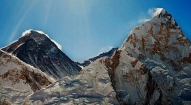
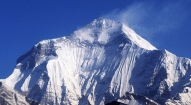
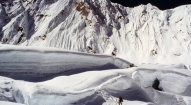
- All ground transfer by private vehicles as per our itinerary
- Fine hotel –Thamel Eco Resort in Kathmandu (twin sharing including b/f and taxes)
- Welcome dinner with live Nepalese cultural program hosted by Makalu Adventure
- Guided sightseeing around Kathmandu world heritage sites including all entrance fees
- All domestic airfares (Kathmandu-Lukla- Kathmandu)
- Everyday three times hot meals while on trekking
- National park, conservation area permit and fees
- Guide, porters, their daily wages, insurances with all necessary lodging / fooding arrangements.
- Administration service during rescue and evacuation (if required)
- Down jacket, sleeping bags, Trekking kit bag/duffel bag, trekking map and trekking Poles
- A comprehensive medical kit
- All government and local taxes
- Nepal visa fee.
- Airport taxes.
- International airfare to and from Kathmandu.
- Excess baggage charges.
- Lunch and evening meals in Kathmandu.
- Extra night accommodation.
- Travel and rescue insurance.
- Personal expenses (phone calls, laundry, bar bills, battery recharge, extra porters, bottle or boiled water, showers etc).
- Rescue and evacuation if required.
- Tips gratitude





